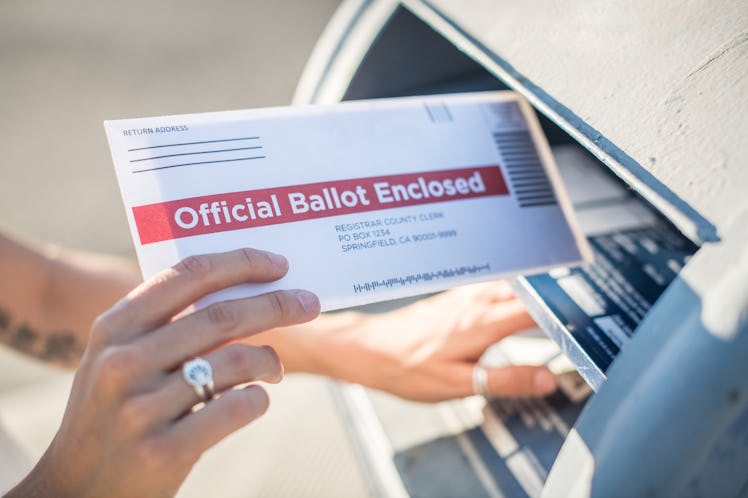
Here’s What To Know About The Difference Between Voting By Mail & Absentee Voting
Due to the ongoing coronavirus pandemic, many people are expected to opt for mail-in voting ahead of Election Day on Nov. 3. Most states have ways for voters to mail in their ballots via absentee voting or mail-in voting, but with terms like absentee ballot and mail-in only being thrown around this election season, you may be wondering if absentee voting is the same as voting by mail.To help you understand, here’s a breakdown of what the terms really mean.
The terms absentee voting and mail-in voting are sometimes used interchangeably, so it can be confusing about what they really mean — and which one you should use to vote. To get a better picture of the ways you can vote this election season, here's a breakdown of these often-used terms.
Voting rules and requirements will always vary state-by-state, but in general, absentee voting refers to when a voter requests a ballot and votes early by mail because they won’t be able to go to their polling place on Election Day, according to USA.gov. There are different types of absentee voting: excuse-required absentee voting, no-excuse required absentee voting, and vote by mail, according to the U.S. Election Assistance Commission. However, there are some states that have mail-in only voting, which is when all registered voters in those states are sent a ballot in the mail without having to request it. According to Vote.gov, absentee voting is also known as mail-in voting and by-mail voting, since you can mail in your ballot before the election. So, absentee voting is usually done by mailing in a ballot, but not every ballot mailed in is an absentee ballot.
As of Sept. 14, seven states employ excuse-required absentee voting, according to The New York Times, which requires a voter to give a valid "excuse" of why they can't cast their ballot in-person on Election Day. Some valid reasons to vote absentee include being out of the county where you are registered to vote on Election Day, being a student living outside the county you’re registered in, or having an illness or disability which prevents you from getting to the polls in person. But the majority of states allow no-excuse absentee voting, which permits voters to submit a ballot by mail for any reason.
When voting via either an excuse-required or a no-excuse absentee ballot, you’ll receive your ballot in the mail, before the election, which you’ll then need to complete and return by mail, or at a voting location or a secure dropbox. You can find out your state’s deadline for receiving ballots here.
In most states, you’ll have to apply for your ballot, as described above, but some states practice all-mail voting as a default, whether or not you’ll be absent on Election Day. This means a ballot is automatically mailed to every eligible voter in the state, even if they don’t request one. Prior to the pandemic, there were five states — Washington, Oregon, Colorado, Utah, and Hawaii — that already employed automatic all-mail voting during elections. For the 2020 election, California, Nevada, New Jersey, Vermont, and Washington, D.C., have also opted to allow all-mail voting during the 2020 election, making the current total nine states, and Washington, D.C. For all-mail voting, once you've completed your ballot, you'll need to mail your ballot back by (or preferably, before) the deadline, or deposit it at a designated location or dropbox on Election Day.
So if you’re looking for a way to vote by mail ahead of the election, you’ll either need to apply for an absentee ballot, or simply return the ballot you receive from your state’s Board of Elections, if you live in an all-mail voting state.
If you do decide to head to the polls on Nov. 3, you'll want to follow the Center for Disease Control and Prevention (CDC) coronavirus safety guidelines for voters as of June 22. The CDC recommends you stay at home if you are sick or if you've been in recent contact with someone with COVID-19. In addition, you'll want to wear a mask, practice proper social distancing, and wash or sanitize your hands after using the voting machine.
Your voice matters. So does your vote. Make sure both are heard and counted in the 2020 election by registering to vote right now.
If you think you’re showing symptoms of coronavirus, which include fever, shortness of breath, and cough, call your doctor before going to get tested. If you’re anxious about the virus’s spread in your community, visit the CDC for up-to-date information and resources, or seek out mental health support. You can find all Elite Daily's coverage of coronavirus here.